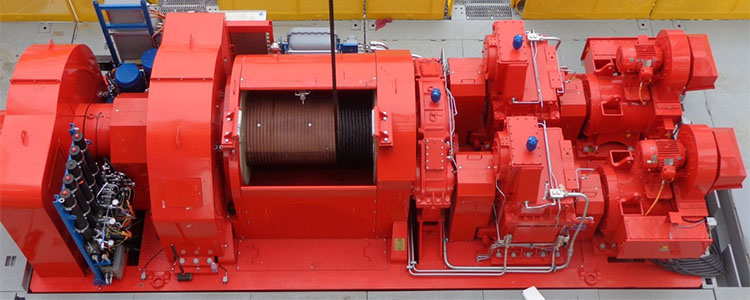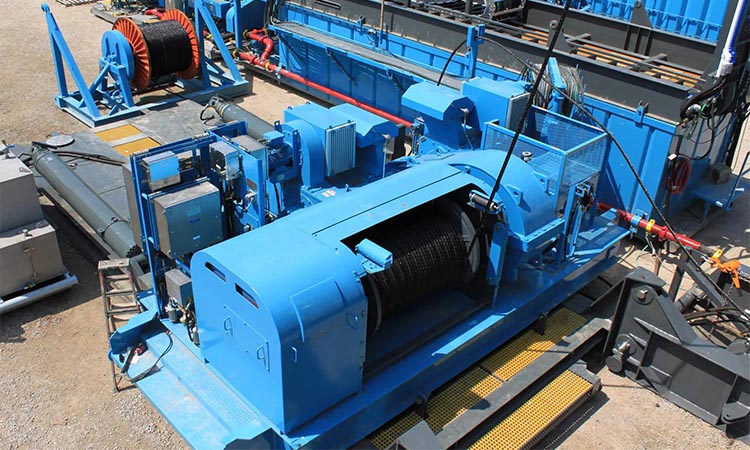Drilling drawworks operating procedures and maintenance
Drilling drawworks operation procedures
1. Before turning on the main motor of the drawworks, first turn on the lubricating oil pump motor. After the lubricating oil circulation is normal, then turn on the main motor and engage the roller clutch (CH1940) for drawworks operation.
2. When the empty elevator is blocked when lowering or when inching operation is required when loading and unloading the drill string, the CH1940 clutch can be operated to engage the main disc brake.
3. In order to meet the requirements of the CH1940 clutch on the intermediate shaft of the reduction box, the total air pressure gauge pressure in the driller's control room should reach 0.7~0.8Mpa. The pressure when lifting the maximum load is not less than 0.75Mpa.
4. During the drilling process, energy-consuming braking is automatically realized due to the characteristics of the motor. It is forbidden to lower the drill string in free fall without using the auxiliary brake, and then brake hard with the main brake. It is recommended that during normal drilling operations, energy consumption braking should be used from the beginning to reduce the kinetic energy of drilling and make it possible to drill at a uniform speed.
5. When dealing with an accident, the turntable clutch and the turntable inertia brake can be operated to realize the turntable jogging or stopping at a certain position. The air control valves of the turntable clutch and the turntable inertia brake are interlocked. When switching between each other during operation, they must stay in the deflation position, that is, the middle "minute" position for 2 to 4 seconds, so that the engaged clutch has sufficient time. Deflate to prevent excessive wear of the friction plate or burning of the rubber pneumatic tire.

Maintenance procedures for drawworkses
Routine inspection and maintenance
Inspection items for each shift:
1. Whether the bolts connecting the drawworks and the base are complete and not loose.
2. Whether the fast rope clamping plate bolts are complete and not loose.
3. Whether the fixing bolts of the brake mechanism are complete and not loose. whether the gap between the friction block and the brake disc is appropriate.
4. Whether the oil level in the oil pool is within the scale range.
5. Whether the gear oil pump pressure is between 0.1 -0.4MPa.
6. Whether each chain is well lubricated and has appropriate tightness.
7. Temperature rise of each shaft end bearing.
8.Whether there is oil leakage at each shaft end, bearing cover, box cover, etc.
9. The minimum air pressure of the pneumatic tire clutch is 0.7Ma.
10. Check whether various air valves, air pipelines, joints, etc. are leaking.
11. Check whether the lubrication pipeline is leaking oil, whether each nozzle is clogged, and whether the nozzle orientation is correct.
12. Whether there are any abnormalities at each transmission location.
13. Whether the water-gas hoist and auxiliary brake seals are reliable, and the cooling water path should be smooth and leak-free.
14.The DC motor runs smoothly without abnormal noise.
Regular inspection
When the drawworks is operated for a period of time, the operating parts will be worn, the connecting parts will be loose, the pipelines will be blocked, the seals will be aged, etc. If the drawworks continues to develop, it will have a negative impact on the use of the equipment. Therefore, Chuk's above-mentioned daily inspections, in addition to general maintenance, also require regular inspections and repairs. Such inspections should be attended by professional mechanics.
Regular inspection every quarter
1. Open the window and the cover (door) on the guard to check the condition of the chain. The chain pins, rollers, and cotter pins must be inspected one by one. Based on the inspection results, determine whether it can continue to be used. When the wear is serious, it should be replaced.
2. Check the wear of the brake friction blocks and replace them if necessary.
3. Check whether the air tire clutch air bag is aged. If the friction block is severely worn, it should be replaced.
4. Check the working clearance of the friction cat head, and adjust the gasket (or replace the friction plate) if necessary.
5. Check the wear of each brake disc and replace it if necessary.
6. Check the wear of the internal and external teeth of the gear clutch.
7. Check the wear of Eaton brake friction discs and friction plates, and replace them if necessary.
8. Check the following components in the oil circuit and clean, replace, repair or adjust them according to the situation:
①Oil tank; ②) Filter; ③Oil line; ④ Grease line;⑤Chain lubrication nozzle; ⑥ Pressure gauge; ⑦ Seals.
Annual regular inspection
1. Check the screws and nuts of all connecting parts. If they are loose, tighten them. Cotter pins, locking wires, etc. must be restored if they are lost or damaged.
2. Check the wear of each bearing. Excessively worn bearings should be replaced.
3. Check that all lubricating oil and grease pipelines should be free of leakage and blockage.
4. Check the clutch mechanism and replace worn parts.
5. Check the wear of sprocket teeth and chain.
6. Check the wear of the brake disc (brake hub) and the condition of the pipelines and joints of the cooling system.
7. Check the wear of the brake pads.
8. Thoroughly clean the oil pool
9. Check the internal condition of the motor and check the alignment.
10. Check the status of all pipelines, valves, and pressure gauge actuators of the pneumatic control system.
11. Check all oil seals.
12. After inspection, determine the parts that should be repaired or replaced.
Supplier of drilling drawworks
Sino Mechanical Equipment provides various oil drilling equipment, such as: drawworks,air winches, traveling block and hook, hydraulic power tongs, slings wire rope , and accessories,etc. We are located in Shengli Oilfield, the second largest oil field in China. We are familiar with drilling procedures and provide high-quality, safe and reliable drilling equipment to the world.


